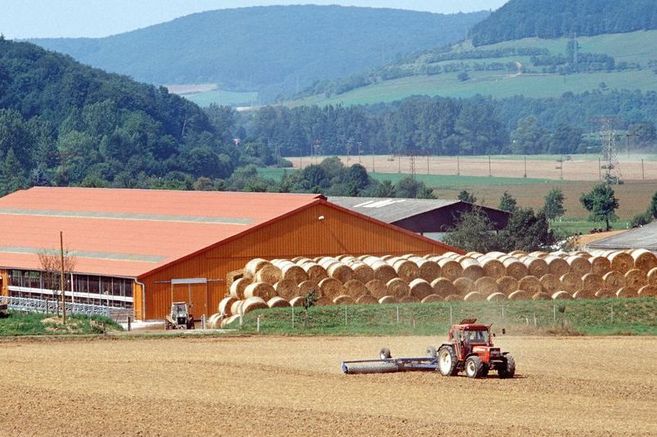Project
TRUSTEE Task "Validation of the implementation logic of RD-measures and the Baseline in the CAPRI model"
To quantify the impact of policy measures for rural development, the development of the pan European model “Common Agricultural Policy Regionalised Impact - The Rural Development Dimension” (CAPRI-RD) was the first important step. During the development process it became clear that measures to promote the rural area can only be modelled successfully, if national experts validate them continuously. In the TRUSTEE project, national experts come together to further continue this procedure.
Background and Objective
In the year 2000, a comprehensive catalogue of measures for promoting rural areas in the EU was established, known as the "second Pillar" of the Common Agricutural Policy (CAP). In addition to the conventional intervention measures of the agricultural policy, which are implemented uniformly in the EU, the second Pillar measures were implemented, which are designed region specific and very divers. They are also different by targeting not only the agricultural holdings but also other sectors in the rural economy. To estimate this impacts and the interrelationships between them, we enhanced in the previous project the modelling system „Common Agricultural Policy Regionalised Impact Modelling System“ (CAPRI) by regional Computable General Equilibrium (CGE) models – the “Common Agricultural Policy Regionalised Impact - The Rural Development Dimension” (CAPRI-RD) evolved. Through this enhancement, all economic sectors of rural areas could successfully be displayed. In the validation of the model results, the direction of the impact of second Pillar measures was confirmed. However, it revealed that it is of high importance to consider the regional differences. This will now be our mission in the TRUSTEE project with assistance of national experts. Furthermore, we will validate the CAPRI baseline, using national and international data, and will include these results in the before mentioned project tasks.
Approach
The CAPRI baseline will be validated together with project partners from Spain and Ireland. For this purpose, the CAPRI baseline will be compiled annually and compared with national and international model results, based on selected indicators. A review will be carried out to compare CAPRI to other models. Significant differences between the models will be analysed and discussed with national experts on the annual Training Sessions. Missing issues will be considered for the CAPRI baseline in the following year. We will use the gained findings from the baseline validation also to validate the simulation of the second Pillar in the model and develop policy scenarios to analyse toppical quetions regarding theCAP.
Data and Methods
For the baseline validation, we will compare the CAPRI baseline with national baselines (or alternatively with other national data) and international data. Evaluation reports should be studied and an extensive literature review will be carried out. For the comparison of model results, different simulations need to be calculated using the CAPRI model.
Our Research Questions
- Is the CAPRI baseline consistent with national and international assessments of the EU Member States?
- Can the CAPRI results regarding the impact of the second Pillar payments for Germany be confirmed through expert interviews and the evaluation reports?
- And if so, how can the model be of use for designing the second Pillar measures after 2020, with regard to policy impact assessment?
- What would be the effect of shifting 15% of the budget from CAP Pillar I to Pillar II?
- How much would be the costs for GHG mitigation through grassland expansion of 5% in the EU?
Results
We provided a review of the methodologies used to generate and validate baselines for agricultural partial equilibrium models at global and regional scale and found that the baseline definition process is quite similar across outlooks. Main differences across outlooks come from baselines being more model-based while others are more expert-based. We provided comparisons between the CAPRI and FAPRI-Ireland. Historical data used in the baselines are different between FAPRI-Ireland and CAPRI. This is because CAPRI makes a consolidation process of supplied data. Main issues in CAPRI baseline for Ireland: Projections by CAPRI are consistent with the historical trend; CAPRI is not in line with the expectations by the stakeholders in some points. We carried out comparison of results and methodology from CAPRI vs official national GHG inventory reports for EU28 (1990-2014). We found CAPRI is well in line, occurring differences are due to technical coefficients (e.g. emission factors, N excretion rate).
While evaluating the model extansion of CAPRI by the regional Computational General Equilibrium models, we found that, besides CAPRI, rarely approaches exist to assess joint effects of all RD measures. Hence, contrary effects of different measures are not considered. However, the intervention logic of CAPRI needs to be improved and deadweight effects and administration costs should be included.
Furthermore, we used the model CAPRI to analyse the impact of a policy for grassland enhancement with respect to GHG mitigation in the year 2020. We analysed how sensible it is to expand the grassland area in the EU by 5%. We found that emissions could be reduced by net 4.3 Million t CO2 with costs of about 417 Million EUR. The net abatement costs would be 97 EUR/t on average, substantial carbon sequestration could be achieved already from 50 EUR/t CO2. However, a policy measure for grassland enhancement would economically and environmentally only make sense if it is regionally targeted.
Finally, we analysed the effect of shifting 15% of budget from the first to the second pillar of the CAP using the CAPRI model for all MS for the year 2025. We found that a higher budget shift would be needed to get a relevant effect on RD policy goals and to also reach intensive production regions, RD measures would need to be more mandatory or more attractive for intensive arable farming systems.
During the project duration, we organized three training sessions and hosted each year between 25 and 36 participants from 10 to 13 different countries, coming from universities, public and private research institutions or governmental institutions (e.g., EU Commission).
Links and Downloads
Thünen-Contact

Involved external Thünen-Partners
-
EuroCare GmbH
(Bonn, Deutschland) - Institut national de recherche pour l’agriculture, l’alimentation et l’environnement (INRAE)
(Paris, Toulouse, Montpellier, Avignon, Ivry-sur-Seine, Clermont-Ferrand, Rennes, Thiverval-Grignon, Dijon, Orleans, Bordeaux, Pierroton, Frankreich) -
Centre National de la Recherche Scientifique (CNRS)
(Paris, Rennes, Montpellier, Frankreich) -
Swedish University of Agricultural Science - SLU
(Uppsala, Lysekil, Schweden) -
Muséum National d’Histoire Naturelle
(Paris, Frankreich) -
University of Perugia
(Perugia, Italien) - University of Latvia / Latvia University of Life Sciences and Technologies
(Jelgava, Lettland) -
University College Dublin
(Dublin, Irland) - Technical University of Madrid (Universidad Politecnica de Madrid) - UPM
(Madrid, Spanien) -
Forest Science and Technology Centre of Catalonia - CTFC
(Solsona, Spanien)
Funding Body
-
Federal Ministry of Research, Technology and Space (BMFTR)
(national, öffentlich)
Duration
9.2013 - 2.2017
More Information
Project status:
finished
Publications to the project
- 0
Schroeder LA, Marquardt S, Gocht A (2018) Cap post 2013: effects of a shift from Pillar I to Pillar II : changes on land use and market effects among types of farms. Routledge Stud Agric Econ 1:199-216
- 1
Gocht A, Espinosa M, Leip A, Lugato E, Schroeder LA, Doorslaer B van, Gomez y Paloma S (2016) A grassland strategy for farming systems in Europe to mitigate GHG emissions - an integrated spatially differentiated modelling approach. Land Use Pol 58:318-334, DOI:10.1016/j.landusepol.2016.07.024
- 2
Espinosa M, Gocht A, Schroeder LA, Leip A, Gomez y Paloma S, Lugato E, Doorslaer B van (2015) Promotion of grassland as strategy to reduce Greenhouse Gas Emission: results for Spain of the EU-wide analysis with the century and the CAPRI models. In: X Congreso de la Asociacion Espanola de economia agraria : alimentacion y territorios sostenibles desde el sur de Europa ; Cordoba, 9-11 de Septembre de 2015. Valencia: Universitat Politecnica de Valencia, pp 227-234
- 3
Schroeder LA, Gocht A, Britz W (2015) The impact of Pillar II Funding: validation of a modelling and evaluation perspective. J Agric Econ 66(2):415-441, DOI:10.1111/1477-9552.12091







